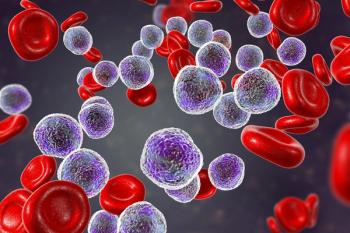
SCRT Followed by Cadonilimab/Chemo Shows Responses in pMMR/MSS Rectal Cancer
The NeoCaCRT trial found that SCRT followed by cadonilimab and mFOLFOX6 elicited a pCR of 37.0%, meeting its primary end point for patients with locally advanced rectal cancer.
Neoadjuvant short-course radiation therapy (SCRT) followed by cadonilimab (AK104) and chemotherapy demonstrated positive pathologic complete responses (pCRs) and an acceptable safety profile in the treatment of patients with mismatch repair-proficient (pMMR) or microsatellite stable (MSS) locally advanced rectal cancer (LARC), according to the open-label, single-arm phase 2 NeoCaCRT trial (NCT05792735) presented at the
At the October 20, 2024, data cutoff, with a median follow-up of 9.7 months, the pCR rate was 37.0% (95% CI, 19.4%-57.6%); the clinical major pathological response rate (MPR) was 55.6% (95% CI, 35.3%-74.5%); and the clinical complete response rate (cCR) was 22.2% (95% CI, 8.6%-42.2%), and among those who achieved a cCR, 83.3% received local excisions.
The investigators also noted that radiological tumor shrinkage underestimated the degree of pathological regression.
“In patients with pMMR/MSS LARC, neoadjuvant SCRT with cadonilimab plus [chemotherapy] resulted in promising pCR rates with a manageable safety profile,” Wan He, a researcher in the Department of Oncology at Shenzhen People’s Hospital in Shenzhen, China, and lead study investigator, stated in the poster. “These data deserve further investigations in a phase 3 randomized trial.”
A total of 27 patients between 18 and 79 years of age with pMMR/MSS stage II to III (cT3-4 or N1) rectal adenocarcinoma located below the peritoneal reflection were enrolled in the trial. Additionally, patients were required to have histologically confirmed disease with an ECOG performance status of 0 or 1 and adequate organ and bone marrow function.
Patients received 5 Gy of SCRT in 5 fractions, then 6 mg/kg of cadonilimab every 2 weeks plus mFOLFOX6 chemotherapy (85 mg/m2 of oxaliplatin, 400 mg/m2 of leucovorin, 400 mg/m2 of 5-fluorouracil bolus on day 1, and 2400 mg/m2 of 5-fluorouracil infusion for 48 hours) for 6 preoperative cycles.2 They then underwent either total mesorectal excision or transanal local excision, and those who did not have a pCR received the adjuvant cadonilimab with chemotherapy for 6 cycles and those who did have a pCR were given the opportunity to choose between the adjuvant treatment or observation. Patients who had a cCR chose between surgery or the “watch and wait” method.
The median age of patients was 58 years (range, 33-71), the majority were male (n = 18), and an ECOG performance status of 0 was most common (n = 24). Twenty-four patients had clinical stage III disease, 15 were extramural venous invasion positive, and 14 had positive mesorectal facia involvement. cT3 disease was most common (n = 15), followed by cT4 (n = 12) and cT3a-b (n = 11); and cN2 (n = 13) and cN1(n = 11) disease were also observed. A distance to the anal verge of 5cm or less was identified in 15 patients and 5.1-10cm in 12.
The trial’s primary end point was pCR. Secondary end points included cCR, MPR, overall response rate, R0 resection rate, disease-free survival, overall survival, safety, and quality of life.
Regarding safety, treatment-related adverse events (TRAEs) of any grade and grade 3/4 occurred in 88.9% and 22.2% of patients, respectively; drug-related AEs in 85.2% and 14.8%; and immune-mediated AEs in 66.7% and 11.1%. TRAEs led to treatment discontinuation in 18.5% of patients, and there were no treatment-related deaths. Grade 3/4 TRAEs include diarrhea (14.8%), neutropenia (3.7%), liver dysfunction (3.7%), type 2 diabetes (3.7%), pneumonia (3.7%), and infusion-related reaction (3.7%).
The most common TRAEs were diarrhea (37%), nausea (37%), fatigue (37%), and neutropenia (26%).
References
- He W, Huang J, Liao G, et al. Short-course radiation (SCRT) followed by 6 cycles of cadonilimab plus mFOLFOX6 as neoadjuvant therapy for patients with locally advanced rectal cancer (LARC): A multicenter, single arm phase 2 trial (NeoCaCRT). J Clin Oncol. 2025;43(4):LBA210. doi:10.1200/JCO.2025.43.4_suppl.LBA210
- Neoadjuvant cadonilimab plus chemotherapy following short-course radiotherapy in locally advanced rectal cancer (NeoCaCRT). ClinicalTrials.gov. Updated June 29, 2023. Accessed January 25, 2025. https://tinyurl.com/es8en7nk
Newsletter
Stay up to date on recent advances in the multidisciplinary approach to cancer.


















































































